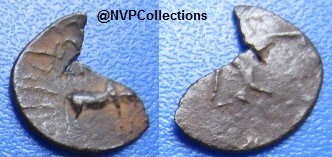East India company was known by Governor and Company of Merchants of London trading in to the East Indies. The original charter was
granted by Queen Elizabeth I on December 31, 1600, under the title of "The
Governor and Company of Merchants of London Trading into the East Indies".
The company was granted a monopoly of trade in Asia, Africa, and America, with
the formal restriction that it might not contest the prior trading rights of
"any Christian prince". The company was managed by a governor and 24
directors chosen from its stockholders.
 |
| EAST INDIA COMPANY FLAG |
Year : 1835
Value: 1/12 Anna
Type: Milled Coin
Obverse: Monarch queen Victoria, Arms of East India Company with date between the scroll and ribbon
Reverse: The Value in English and Persian
Diameter: 18mm
Metal : Copper
Year : 1835
Value : 1/4 Anna
Metal : Copper
Year : 1835
Value : 1/2 Anna
Metal : Copper
Year : 1858
Value : 1/4 Anna
BENGAL PRESIDENCY
In 1633 a group of 8 Englishmen obtained a permit to trade in Bengal from the Nawab of Orissa. Shortly thereafter trading factories were established at Balasore and Hariharpur. Although greater trading privileges were granted to the East India Company by the Emperor Shah Jahan in 1634. By 1642 the two original factories were abandoned. In 1651, through an English surgeon named Broughton, a permit was acquired to trade at Benegal. Hugli was the first location, followed by Kasimbazar, Balasore and Patna (the last three in 1653). Calcutta became of increasing importance in this area and on December 20, 1699 Calcutta was declared a presidency and renamed Fort Wililam.
Monetary System : Rupee=64 Pice=192 Pie (Mohur=15 Rupees)
Mints : Alinagar Kalkatah (Calcutta), Azimabad (Patna), Banaras (Banares, Varanasi), Calcutta (Kalkatah), Farrukhabad, Jahangirnagar, Muhammadabad Banaras, Murshidabad, Patna and Sagar.
Monetary System : Rupee=64 Pice=192 Pie (Mohur=15 Rupees)
Mints : Alinagar Kalkatah (Calcutta), Azimabad (Patna), Banaras (Banares, Varanasi), Calcutta (Kalkatah), Farrukhabad, Jahangirnagar, Muhammadabad Banaras, Murshidabad, Patna and Sagar.
Metal : Copper
Mint : Farukhabad
Year : 1826
BOMBAY PRESIDENCY
The Bombay Presidency was a province of British India. It was first established at Surat in the 17th century as a trading post for the English East India Company.
The Bombay Presidency comprised the present-day state of Gujarat, the western two-thirds of Maharashtra state, including the regions of Konkan, Desh, and Kandesh, and northwestern Karnataka state of India; it also included Pakistan's Sindh province.
Metal : Copper
Year : 1802-1829
Value : 1/2 Paisa
Obverse : U.E.I. co Bale mark
Reverse : Scales
Reference : Krause KM #197
Metal : Copper
Year : 1802-1829
Value : 1 Paisa
Obverse : U.E.I. Co. Bale Mark
Reverse : Scales
Reference: Kruase KM #198
Metal : Copper
Year : 1803
Value : Pice
Obverse : Center of U.E.I. Co Bale Mark
Reverse : Date 1803
Weight : 2.2 Grams
Reference : Kruase KM #203
Metal : Copper
Year : 1807
Value : Pice
Obverse : Center of U.E.I. Co Bale Mark
Reverse : Date 1807
Reference : Kruase KM #203
Metal : Copper
Year : 1833
Value : 1/4 Anna
The Madras Presidency, officially the Presidency of Fort St. George and also known as Madras Province, was an administrative subdivision of British India.
The presidency included much of southern India, including the present-day Indian State of Tamil Nadu, the Malabar region of North Kerala, Lakshadweep Islands, Part of Andhra and Karnataka. The presidency had its winter capital at Madras and summer capital at Ootacamund.
Metal : Copper
Year : 1825
Value : 2 Cash
Metal : Copper
Year : 1808
Value : 10 Cash
Metal : Copper
Year : 1808
Value : 20 Cash
Metal : Copper
Type : Hammered Coin
Year : 1797
Value : Cash
Obverse : Inverted Heartshield with "V.E.I.G"
Reverse : Date 1797
Weight : 0.95 grams



































